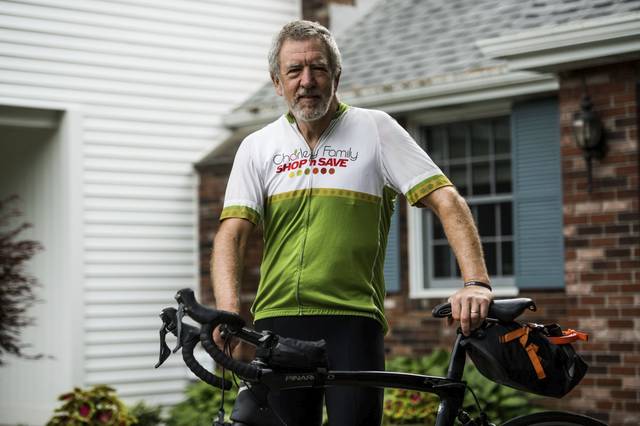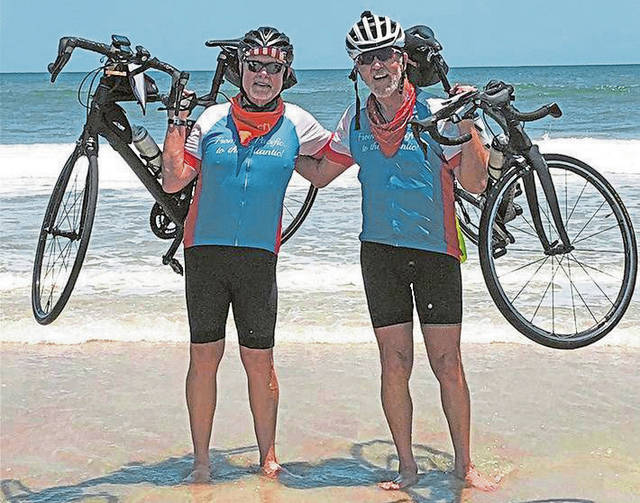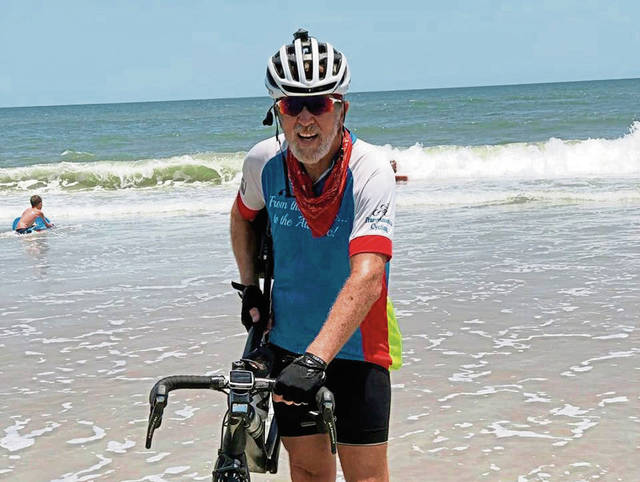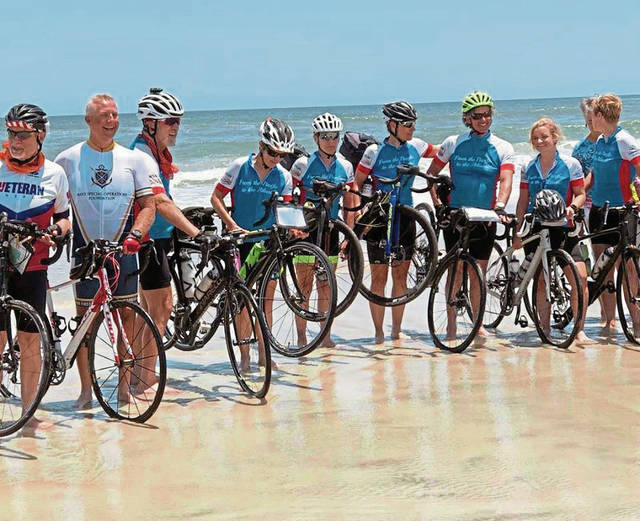Q&A: Charley Shop'n Save owner bikes across U.S. for veterans' charity
Ray Charley biked 2,000 miles to prepare for his 3,048-mile, 48-day trek across the United States.
“The training was a feat unto itself, really,” said Charley, 68, of Unity, whose family owns Shop’n Save locations in Murrysville, Greensburg and Hempfield.
Charley left San Diego, Calif., on April 1. He reached St. Augustine, Fla., on May 19. Along the way, he peddled across parts of seven states along the U.S. southern border.
By the midpoint of the trip, Charley found himself in a strange position.
“We’d go over the next day’s ride, and I would occasionally be able to say, ‘Thank God, it’s only going to be a 65-mile day,’ ” he said.
The 14 cyclists in Charley’s group raised money for different veteran charities. Charley raised money for Feherty’s Troops First Foundation. At the Westmoreland County Air Show over Memorial Day weekend, he presented a check for more than $73,000 — the product of his ride as well as other Shop’n Save fundraisers.
Charley sat down with the Tribune-Review to discuss his his cross-country journey and once-in-a-lifetime experience.
Do you need a nicely padded bike seat for this type of trip?
For anyone who rides distance, until you get to a certain point, the seat just hurts. But after a while, it doesn’t hurt at all. I can ride 70 or 80 miles now, and it’s not my bottom that hurts, it’s usually whether my legs have the juice to keep going. There’s sort of a misconception that you need a thick, padded seat to give you more cushion. But you just have to be on the bike.
What time would you usually start?
We’d get up between 5:30 and 6:30 a.m., depending on how long the day was going to be. If it was a shorter, 60- or 70-mile day, there was no reason to leave at sunrise. But most days we’d be up at 6:30 a.m., have breakfast, have the bikes prepped and be on the road at 7:30 a.m.
Was there a particular day where you thought you might have bit off a little more than you could chew?
We had some days that were gargantuan. One was a 90-mile day where we climbed 6,000 feet of elevation. And I thought that, if I could get through that, I’d be OK. That was within the first two weeks of starting the ride. We had another day where the ride was really long, the road was rough and the wind was in our faces all day long. For the last five miles, my partner and I would remind each other how close we were. “Just a few miles left,” and even though you can’t see the destination, you know it’s there. But the road surface was just brutal, very rough. Those two days really stand out. I had to reach as deep down as I could just to finish.
When you were on the road, how much gear did you carry?
You try to minimize that, because it’s just more weight (a trailer following the group carried extra gear). But I always carried a rain jacket and rain covers for my shoes, whether it was sunny or not. I wanted to have those in my kit so if I got caught in a thunderstorm, I’d have some protection. Then I’d have my tool kit, spare tubes and things like that. The farther along we got, the less I carried. As we made our way east or as the day went on, the temperatures were hotter and I didn’t need as much clothing. … There were days when we’d get up and it was in the 30s, and there were other days we’d get up and it was 75 degrees at daybreak and 100 in the afternoon.
How did the average day go for the group on the road?
It wasn’t like 14 people going on the road all in one group. We’d sort of auto-select, based on who else rides at the pace you ride. It would usually be three or four groups. My partner and I were the “Charles Kuralt” group. We’d stop and talk with people and weren’t in a big hurry. We just wanted to try and make it in time for the evening meeting, get showered and do our laundry. We’d go over the route every evening when we’d go in. There’d be a meeting at 5 o’clock to go over the following day’s ride, where the rest stops would be, that sort of thing.
What was the biggest challenge for you?
Some of the road surfaces were very rough. With a rough surface on a road bike, you let some air out of your tires to try and take some of the bounce out of it, because that beats you up. But every day was unique and an adventure. Each one had its own set of challenges. When you’ve ridden a bike for over 5,000 miles in a year, the greatest challenge is in your head. I knew when I started the ride that I’d done 2,000 miles just to get ready, so I could do 3,000 miles. It was a matter of keeping my head focused and staying on task.
What did you enjoy the most?
I made some really wonderful friends.
Was boredom ever an issue?
It’s a pretty solitary kind of event. But my riding partner and I became close. We had a great adventure together. We’d talk quite a bit throughout the day, and there was always something to keep your attention. We rode days in the desert, and you’d ride through multiple kinds of desert, from ‘Lawrence-of-Arabia’-style, all-sand desert in eastern California, to rock deserts, almost a sort of Biblical desert where seemingly nothing would grow. I took lots of pictures of flowers. Because you’d be riding, and out of this group of rocks, there’d be this beautiful flower growing and you’d think, “How could this happen? How could that seed have blown all this way, gotten here and found that tiny microscopic space with soil to grow in?” There was certainly evidence of God’s glory everywhere we went.
You were posting regular Facebook videos throughout the ride. Was the feedback encouraging?
Beyond what you can imagine. Everyday I’d write, post pictures of that day’s ride and talk about why I took them. My son, Tom, would often take those and move them over to our Facebook page. But I’d always see posts with words of encouragement, and it was always helpful. Seeing friends, family and our greater family — the community — pulling for me really gave me a great lift.
How did your health hold up during the trip?
I had some heart issues a year ago, and during my physical prior to the ride, my doctor said ride as far as I want. Plus one of the riders in our group was a physician, so that’s the way to do it!
What did you learn from talking with people along the way?
With this being a ride to raise funds and awareness for veterans with (post-traumatic stress disorder), it was amazing to see how many people had someone in their sphere who is suffering from PTSD. It was really an eye-opening experience, because that’s not something you usually just ask someone about. We met other veterans, people who were able to get in touch with professionals to find help. But without exception, we’d always find people with friends, family or others they knew having problems with PTSD. So we believe the ride and the fundraising effort will really have an impact for veterans.
When you got to the East Coast, did you throw your bike into the ocean?
I didn’t throw the bike in, but I definitely ran in myself. We did dip our rear tires in the Pacific when we started, and then dipped the front tires in the Atlantic when we finished. After that, I was frolicking in the water in my full biking outfit.
Any plans for more long-distance rides?
My partner and I were talking about maybe doing an October ride from New Orleans up to Nashville, called the Natchez Trace Ride, or possibly something in Florida next winter.
Patrick Varine is a TribLive reporter covering Delmont, Export and Murrysville. He is a Western Pennsylvania native and joined the Trib in 2010 after working as a reporter and editor with the former Dover Post Co. in Delaware. He can be reached at pvarine@triblive.com.
Remove the ads from your TribLIVE reading experience but still support the journalists who create the content with TribLIVE Ad-Free.




